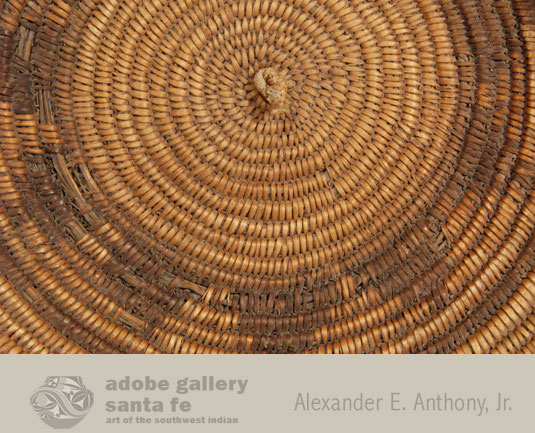Navajo Early Twentieth Century Ceremonial Basket [SOLD]
+ Add to my watchlist Forward to Friend
- Category: Bowls and Other Forms
- Origin: Diné of the Navajo Nation
- Medium: sumac, yucca
- Size: 2-½” deep x 11-½” diameter
- Item # C4091B SOLD
When the members of today’s Navajo tribe arrived in the Southwest around 1500, they were a nomadic people of Athapaskan heritage from the north. On arrival, they split into what we know today as Navajo and Apache tribes. The Navajo settled in northern New Mexico, mingled with the Pueblo peoples and adopted some of their culture. They planted corn and other crops and settled into semi permanent family camps. Their ceremonial life became more elaborate once they settled.
The Pueblo Revolt of 1680 had effects on the Navajo as well. When the Spanish reconquest forced many Pueblo people to flee their villages, they took refuge among the Navajos. The Navajos accepted the refugees and, during the period between 1700 and 1770, they acquired many skills and practices which are accepted today as Navajo tradition. Among these, was basket weaving.
The Navajo made baskets for daily use, particularly after their release from imprisonment at Bosque Redondo. Each Navajo family was alloted two sheep and their personal belongings at the time of their release. Materials for making baskets were free so their use became routine. Following the devastation of their lives during imprisonment, ceremonial functions became important to restore their health and for the well being of their home, flocks, and fields, and for their security.
The Navajo learned basket making from Pueblo families. They made baskets for ceremonial functions—weddings and healing ceremonies, particularly. The traditional wedding basket design that is standard today was not used in the nineteenth century. Most of the surviving examples display a variety of designs—spider woman crosses, zigzag lines, angular hooks, etc.
This basket has a design that shows the beginnings of today’s ceremonial basket design, an indication that it is from the very early 1900s. It has a single row of stepped black triangles but is missing the bands of red seen in later twentieth century ones. Instead of red bands, the remainder of the basket is the natural golden color yucca fiber. Another feature of the older baskets is their construction of two sumac rods topped with twists of yucca fiber. The black design was obtained by dying the yucca fiber.
An unusual aspect of this basket is the treatment of the ceremonial line break. As is still traditional today, the line break in the circular bands always is located at the point where the herringbone rim stitching terminates. The explanation for this is that the medicine man can locate the line break in a dark hogan by running his fingers around the rim. In a healing ceremony the line break must point to the east. The unusual aspect of the line break here is the extension of the brown dyed yucca for another five rows of weaving, a most unusual occurrence.
Condition: this Navajo Early Twentieth Century Ceremonial Basket has some missing stitches, expected in a basket over a hundred years old.
Provenance: from the personal collection of Santa Fe dealer and collector Marti Struever, who acquired it in 2006 and displayed it in her private living quarters.
Reference: Southwestern Indian Baskets - Their History and Their Makers by Andrew Hunter Whiteford, School of American Research Press, Santa Fe. 1988

- Category: Bowls and Other Forms
- Origin: Diné of the Navajo Nation
- Medium: sumac, yucca
- Size: 2-½” deep x 11-½” diameter
- Item # C4091B SOLD



